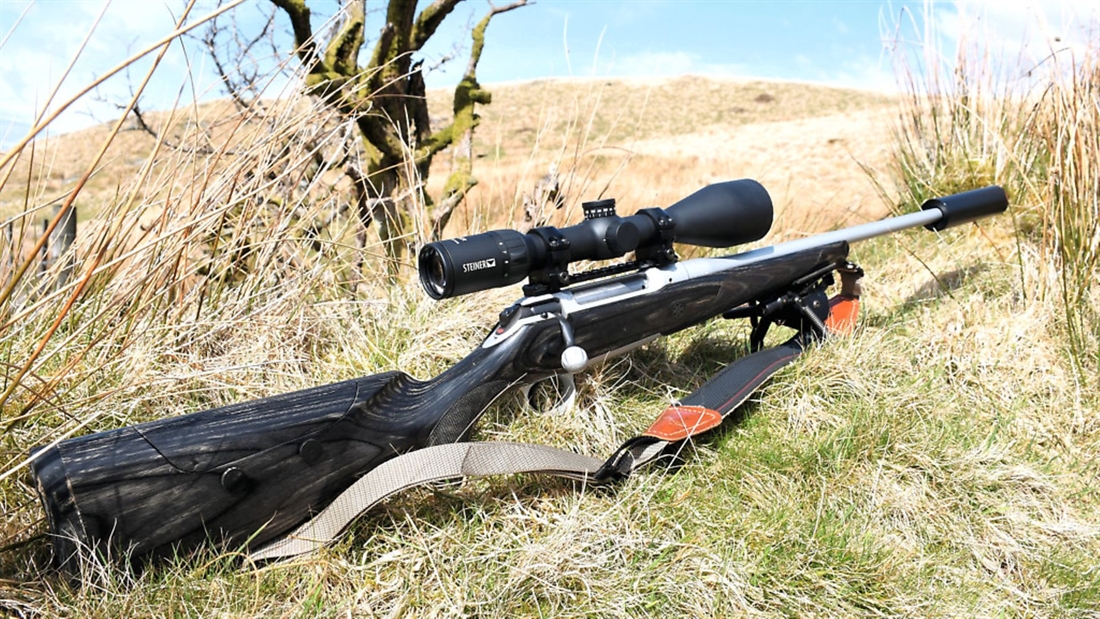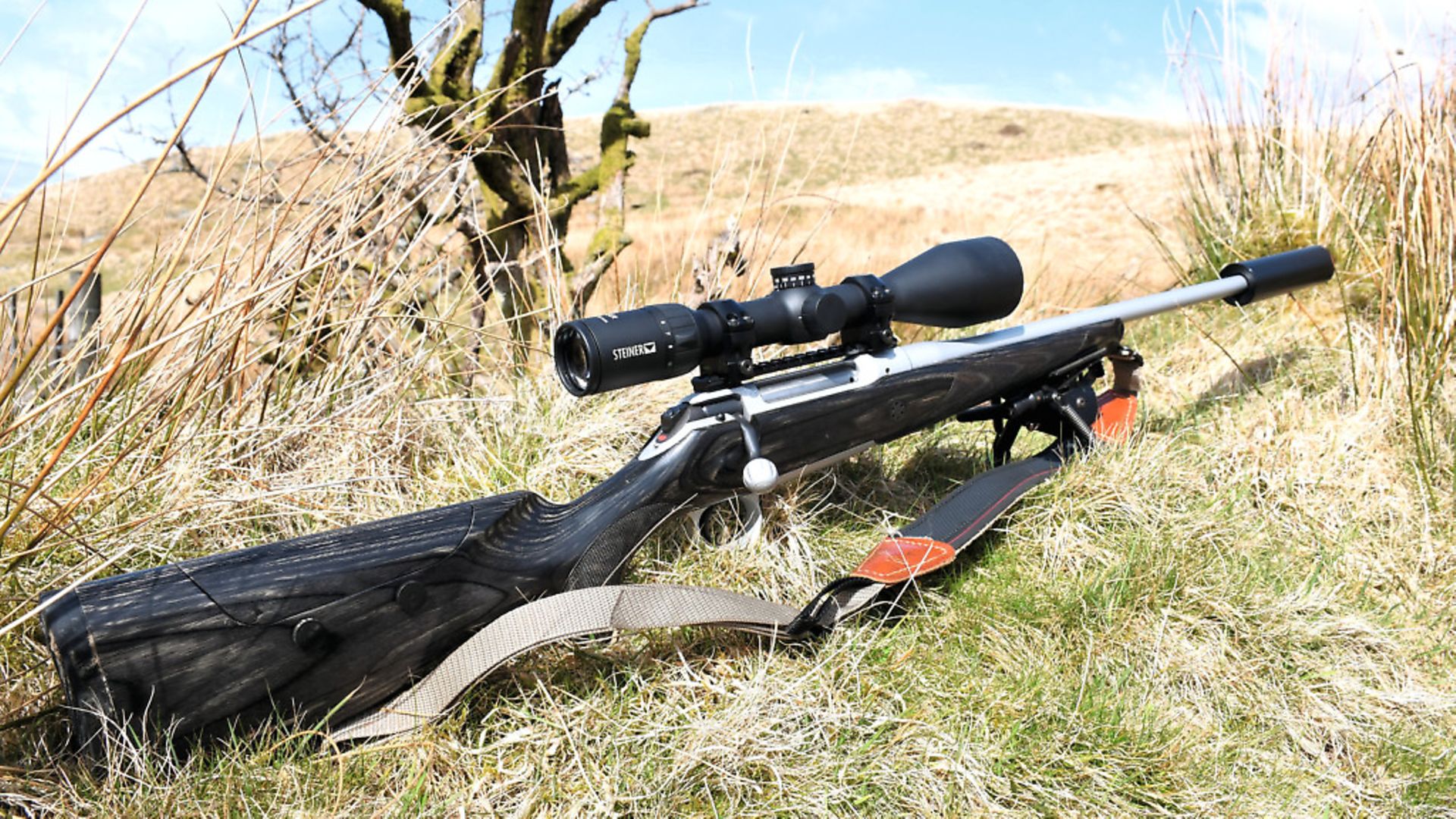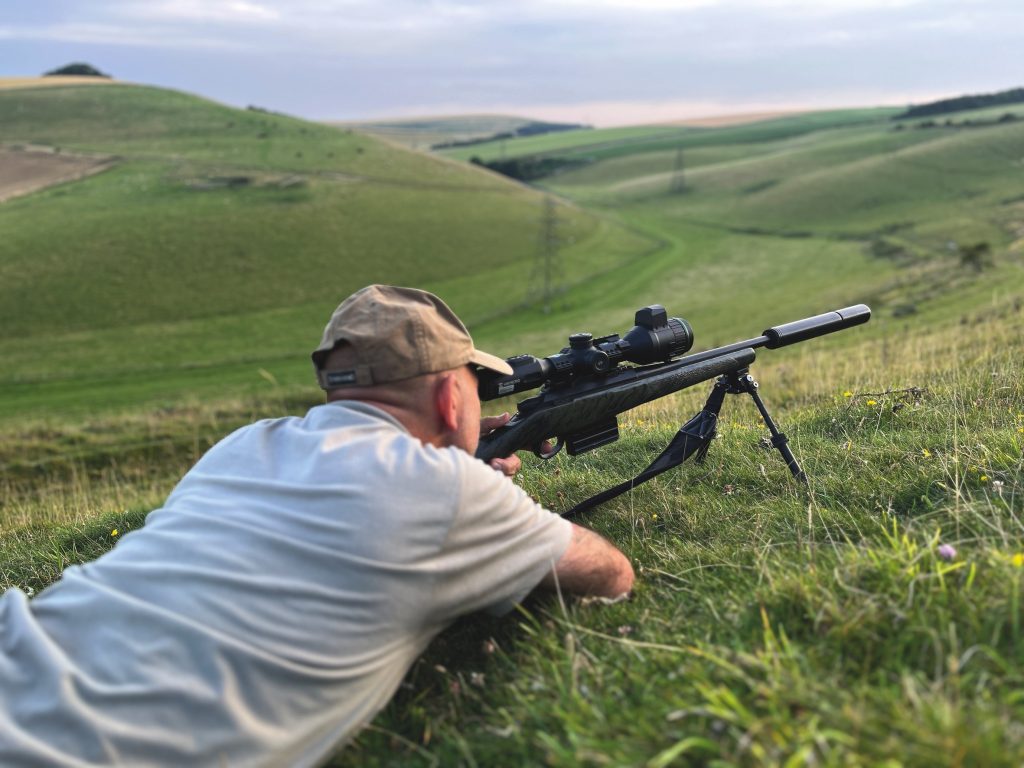Steiner Ranger 4-16×56 BT Riflescope with 4A-I Reticle – TEST & REVIEW

Chris Parkin tests the Steiner Ranger 4-16X56 BT riflescope with 4A-I reticle in this in depth riflescope review… better than try before you buy!
Pros: A simple setup to use; Classy looks to the optic with no heirs and graces; Sharp image quality and a well-defined reticle with simple illumination control; No backlash on the parallax controls
Cons: The adjustment clicks are delicate and may benefit from stiffer springing; Accompanied with slightly more aggressive knurling on the controls for grip
Overall: I think the Steiner shows great capabilities for its price. It may not have quite the brightest glass but is certainly reliable and, most importantly, not lacking in mechanical capability and durability with an assuring warranty. I would deem it to perform above its competitors in the price point with similar specifications
TECH SPECS
Objective lens: 56mm
Magnification: 4-16x
Overall weight: 720gr
Overall length: 368mm
Temperature range: -25/65 degrees
Exit pupil: 12.0-4.5mm
Field of view: 9.2-2.3m @ 100m
Eye relief: 90mm
Dioptre adjustment: -3/+2
Parallax: 50m to Infinity
Reticle: 4A Illuminated, 2nd focal plane
Click value: 1cm @ 100m
Maximum elevation and windage: 85 elevation, 55cm windage @ 100m
Tube diameter: 30mm
Waterproof: 2m, Nitrogen charged
Warranty: 10 years (2 years on electronics)
Accessories: Rubberised lens caps
RRP: £1,135
CONTACT: GMK Limited 01489 579999 www.gmk.co.uk
IN DEPTH REVIEW
Steiner’s new ‘ballistic control’ is an additional turret component that can be added to their Ranger scopes or ordered from the word go on a new unit. The Ranger scope is a discreet optic that embodies all that is good about the German brand’s range by relying on solid, cost-effective performance without too much marketing hype.
This 56mm objective riflescope shows a 4-16x magnification range that is ideal for UK shooters wanting to control foxes and deer stalk on larger areas, where the additional top-end magnification with a fine reticle makes precisely aimed shots a little easier, especially on smaller quarry. For a hill stalker wanting to engage deer within 150-200m you have all you need, but should you need backup shots or to take shots at more extended ranges in culling situations, the ability to dial out further is a blessing. The aluminium tube carries a smooth matt finish (not prone to looking dirty from skin abrasion) with clean lines towards a central, spherical saddle for the inner mechanics, and an equally radiused swelling up towards the ocular body with a rubberised control collar along the way. This scope doesn’t snag easily on foliage or clothing, and I like the look of it with no gaps or crevices to trap dirt and create abrasive paste at mechanical junctures.
There is a small wing on the zoom control just below 8x that’s great for tactile use in the dark, and the fast focus eyepiece shows a broad range from +2/-3 dioptre.
The left side of the saddle shows a parallax dial operating backlash-free from 50m to infinity with an illumination control for the central dot in the 4A-I reticle in the second focal plane. The rotary control is marked from 0-6 in moonlight mode with 7-11 as daylight settings. Each step has an intervening ‘off’ stage to save on time, allowing you to have one click from ‘off’ to your desired setting.
There are no automated positional controls or timer to save the battery, but it’s easy enough to replace the CR2032 if flat (it’s under a capped head to the control that doesn’t need a coin or screwdriver to unfasten).
The dials could perhaps benefit from a little more aggressive knurling but have been designed to accompany the styling ethos of other similar elements on the optic. Larger diameter dials and heavier clicks always make it easier to feel the applied adjustments, but their size on a sporting rifle has to be a compromise in fairness, otherwise they would become too bulky.
Each capped dial for windage or elevation conceals a finger-adjustable knob with 80x 1cm@100m clicks per rotation. Zeroing is accomplished within the 85cm (10.5 turns) available vertically with 55cm available laterally for windage, with 1cm@100m values corresponding to mRad calculations on ballistic programs for an intuitive system that tracked and adjusted on target, to my delight.
You can stay simple like this, but if you want the BC system, after zeroing, the secondary kit within the outer box can be fitted. This contains a high-quality Phillips screwdriver allowing you to remove the twin screws atop the elevation dial and, after very carefully not losing them, lift off the cap.
The kit contains five engraved aluminium collars corresponding to approximate ballistic solutions, for which Steiner provides a rough guide within the included brochure. There are detailed instructions on how to pick the best for your cartridge and, yes, they are approximations and won’t delight the true ballistic gurus out there. But these are intended for hunting ranges, not long-range precision, and will certainly give adjustments appropriate for remaining within the kill zones of relevant quarry species.
Boringly, as ever, with anything labelled long-range, I must add the caveat that you really need to know what you are doing for this sort of stuff. Practice with familiarisation to the kit is well worth the time and ammunition used – it’s not a matter of ‘range things and shoot them’; life and death is not that simple.
I was using a Sauer 101 in .308 Win with Hornady 178gr Precision Hunter ammo, so I chose dial 4 with markings out to 400m. The clicks are quite delicate so take your time and do the set-up in a relaxed, noise-free environment so you can hear if anything moves.
After placing the collar in line with the 100m zero marker, push the replacement dial cap over it, and the rubber O-ring within it will hold the position until you tighten both screws back in place. I cannot stress enough not to do this over a grassy surface as the screws are less than 5mm in length and you will be lucky to find them if dropped.
Each dial shows a drop figure for 400m and the closest to your calibre is the one to use, but variations within calibres and bullet designs are the two main variables. Muzzle velocity and ballistic coefficient will alter the exact shape of your parabolic trajectory, but dial 4 seemed to suit my known ballistics quite well and, when used on steel targets out to 355m using the dial on the BC and beyond, using the continued 0.1 mRad markings, I found it to be a good match. It is, of course, fast to use when you have immediate access to the direct shot distance measurement and it is visible from the shooting position.
I was able to make first-round hits within steel silhouette kill zones and, for a deliberately brief and dumbed down trajectory test, came away very happy. Practice and testing are crucial, however. I have done this more times with more scopes than I can remember, so it’s easy to forget how regular it is to me, but following the supplied instructions should help as they are clear and concise.
Optically, Steiner are good for their price point, and enjoy reliable mechanics in my opinion. They hover in the tumbleweed middle ground with a +£1k price tag and don’t reach the optical ability of their higher echelon peers. Yet in daylight conditions on stalking lands, the colour contrast and sharpness of the image and its crisp 4A reticle within were ideal.
Little light bleed was emitted from the fibre optics in the illuminated reticle; even at an ultra-high daylight setting (used in darkness to highlight the ‘bleed’), the red dot stayed sharp and small with simple fast adjustment.
I feel rotary controls need less effort than push buttons, with more balanced forces needed, therefore correspondingly less physical disruption to your alignment! The mechanics and glass are good, the lens grinding is good and, yes, like all optics, it has a plethora of coatings and is certainly no slouch.
But as can be expected on a scale of price, it does show slightly fewer minutes of performance as the light fades. Yet a hunting trip last year using its smaller 42mm brother still allowed me to take a shot on a Whitetail deer well into dusk, so I was very happy to carry the 56mm unit on a trip in the UK, knowing I could rely on it, and I rarely ever travel with one gun, and never without a spare optic.
Related Articles
Get the latest news delivered direct to your door
Subscribe to Rifle Shooter
Elevate your shooting experience with a subscription to Rifle Shooter magazine, the UK’s premier publication for dedicated rifle enthusiasts.
Whether you’re a seasoned shot or new to the sport, Rifle Shooter delivers expert insights, in-depth gear reviews and invaluable techniques to enhance your skills. Each bi-monthly issue brings you the latest in deer stalking, foxing, long-range shooting, and international hunting adventures, all crafted by leading experts from Britain and around the world.
By subscribing, you’ll not only save on the retail price but also gain exclusive access to £2 million Public Liability Insurance, covering recreational and professional use of shotguns, rifles, and airguns.
Don’t miss out on the opportunity to join a community of passionate shooters and stay at the forefront of rifle technology and technique.





